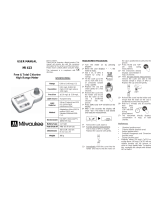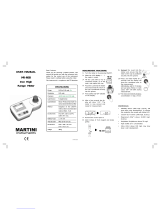Page is loading ...

USER MANUAL
MI 406
Free Chlorine Meter
Dear Customer,
Thank you for choosing a Martini product.
This manual will provide you with the
necessary information for the correct use of
the instrument.
Please read it carefully before using the
meter. This instrument is in compliance with
directives.
SPECIFICATIONS:
Range 0.00 to 5.00 mg/L Cl2
Resolution 0.01 mg/L (0.00-3.50 mg/L);
0.10 mg/L (above 3.50 mg/L)
Precision ±0.04 mg/L @ 1.50 mg/L
Light Source Tungsten lamp
Light Detector Silicon Photocell and
525 nm narrow band interference filter
Method Adaption of the USEPA method 330.5 and Standard Method 4500-Cl G.
Environment 0 to 50°C (32 to 122°F);
100% RH max.
Battery Type 1 x 9 volt
Auto-Shut off After 10' of non-use
Dimensions 192 x 104 x 52 mm
(7.5 x 4.1 x 2”)
Weight 380 g
MEASUREMENT PROCEDURE:
1• Turn the meter on by pressing
ON/OFF.
2• When the LCD displays “- - -”, the
meter is ready.
3• Fill the cuvet with 10
mL of sample, up to the
mark, and replace the
cap.
4• Place the cuvet into the
holder and ensure that
the notch on the cap is
positioned securely into
the groove.
5• Press ZERO and “SIP”
will blink on the display.
6• After a few seconds the
display will show “-0.0-
”. The meter is now
zeroed and ready for
measurement.
7• Remove the cuvet. Open it.
8• Add 3 drops of DPD 1 indicator and
3 drops of DPD 2 buffer to an empty
cuvet. Immediately add 10 mL of
unreacted sample. Replace the cap
and shake gently.
9• Replace the cuvet into the holder
and ensure that the notch on the cap
is positioned securely into the
groove.
10• Press READ and “SIP”
will blink during
measurement.
11• The instrument directly
displays the
concentration in mg/L of free
chlorine.
Interferences
• Positive error:
- Bromine
- Chlorine Dioxide
- Iodine
- Oxidized Manganese and
Chromium
- Ozone
• Alkalinity above 250 mg/L CaCO3 or
acidity above 150 mg/L CaCO3 will
not reliably develop the full amount
of color or it may rapidly fade.
To resolve this, neutralize the
sample with diluted HCl or NaOH.
• In case of water with hardness
greater than 500 mg/L CaCO3,
shake the sample for approximately
2’ after adding the powder reagent.

GUIDE TO DISPLAY CODES:
This prompt appears for 1 second each
time the instrument is turned on.
The dashes “- - -”
indicates that the
meter is in a ready
state and zeroing can
be performed.
Sampling In Progress.
Flashing “SIP” prompt
appears each time the
meter is performing a
measurement.
“-0.0-”, the meter is in
a zeroed state and
measurement can be
performed.
The blinking "BAT"
indicates that the
battery voltage is
getting low and the
battery needs to be
replaced.
“-bA-”, the battery is
dead and must be
replaced. Once this
indication is displayed,
the meter will lock up.
Change the battery
and restart the meter.
“Conf”, the meter has
lost its configuration. Contact your
dealer or the nearest Martini Customer
Service Center.
ERROR MESSAGES
On zero reading
• Blinking “-0.0-” indicates that the
zeroing procedure failed due to a low
signalto-noise ratio.
In this case
press ZERO again.
• “no L”, the
instrument can not
adjust the light
level. Please check
that the sample
does not contain
any debris.
• “L Lo”, there is
not enough light to
perform a
measurement.
Please check the
preparation of the
zero cuvet.
• “L Hi”, there is too
much light to
perform a
measurement.
Please check the preparation of the zero
cuvet.
On sample reading
• “-SA-”, there is too
much light for the
sample
measurement.
Please check if the
right sample cuvet is
inserted.
• “Inv”, the sample
and the zero cuvet
are inverted.
• “ZErO”, a zero
reading was not
taken. Follow the instruction in the
measurement procedure for zeroing the
meter.
• Under range. A blinking “0.00”
indicates that the sample absorbs less
light than the zero
reference.
Check the procedure
and make sure you
use the same cuvet
for reference (zero)
and measurement.
• A flashing value of
the maximum
concentration
indicates an over
range condition.
The concentration of
the sample is beyond
the programmed range: dilute the
sample and re-run the test.
BATTERY REPLACEMENT
Battery replacement must only take
place in a non-hazardous environment.
Simply rotate the battery cover on the
back of the meter.
Detach the
battery from
the terminals
and attach a
fresh 9V
battery while
paying
attention to
the correct
polarity.
Insert the battery and replace the cover.
ACCESSORIES:
MI506-100 Free Chlorine (100 tests)
MI0001 Glass cuvets (2 pcs)
MI0002 Caps for cuvets (2 pcs)
MI0003 Stoppers for cuvets (2 pcs)
MI0004 Tissue for wipping cuvets
(4 pcs)
MI0005 9V battery (1 pc)
WARRANTY
This instrument is warranted against defects
in materials and manufacturing for a period of
two years from the date of purchase.
If during this period the repair or replacement
of parts is required, where the damage is not
due to negligence or erroneous operation by
the user, please
return the meter to either distributor or our
office in the original packing and the repair
will be free of charge.

Damages due to accidents, misuse,
tampering or lack of prescribed maintenance
are not covered.
/

